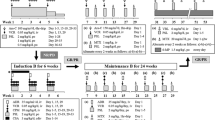Abstract
Little information is available regarding effective systemic therapies for adult Langerhans cell histiocytosis (LCH). The Japan LCH Study Group has formulated an ambulatory treatment regimen for adult patients with LCH. In total, 14 patients (median age 43 years, range 20–70 years) with multifocal LCH with biopsy-confirmed histology were enrolled. None had received cytoreductive agents for LCH previously. Four had single system (SS) and ten had multi system (MS) disease. All were treated with the Special C regimen, which consists of vinblastine/prednisolone and methotrexate with daily 6-mercaptopurine for 36 weeks. At the end of the therapeutic regimen, all SS patients achieved no active disease (NAD), and six of the ten MS patients showed a response (NAD in two, partial response in four). At the last follow-up (median 34 months), 11 patients were alive (NAD in eight and active disease in three). Of the three deceased, one died of hemorrhage during the Special C treatment, and two of infections during subsequent therapy. Although this study is limited by the small sample size, this ambulatory regimen shows signs of efficacy for adult LCH. This was particularly evident for patients with multifocal SS disease, but half of those with MS disease also benefited.

Similar content being viewed by others
References
Stockschlaeder M, Sucker C. Adult Langerhans cell histiocytosis. Eur J Haematol. 2006;76:363–8.
Stålemark H, Laurencikas E, Karis J, Gavhed D, Fadeel B, Henter JI. Incidence of Langerhans cell histiocytosis in children: a population-based study. Pediatr Blood Cancer. 2008;51:76–81.
Allen CE, McClain KL. Langerhans cell histiocytosis: a review of past, current and future therapies. Drugs Today (Barc). 2007;43:627–43.
Tazi A. Adult pulmonary Langerhans’ cell histiocytosis. Eur Respir J. 2006;27:1272–85.
Aricò M, Girschikofsky M, Généreau T, Klersy C, McClain K, Grois N, et al. Langerhans cell histiocytosis in adults. Report from the International Registry of the Histiocyte Society. Eur J Cancer. 2003;39:2341–8.
Morimoto A, Ikushima S, Kinugawa N, Ishii E, Kohdera U, Sako M, et al. Improved outcome in the treatment of pediatric multifocal Langerhans cell histiocytosis: results from the Japan Langerhans Cell Histiocytosis Study Group-96 protocol study. Cancer. 2006;107:613–9.
Gadner H, Grois N, Pötschger U, Minkov M, Aricò M, Braier J, et al. Improved outcome in multisystem Langerhans cell histiocytosis is associated with therapy intensification. Blood. 2008;111:2556–62.
Saven A, Burian C. Cladribine activity in adult Langerhans-cell histiocytosis. Blood. 1999;93:4125–30.
McClain K, Allen C, Ebrahim S. Review of histiocytosis treatment and neurotoxicity in adult patients. Pediatr Blood Cancer. 2009;53:696 (Abstract of 24th Annual Meeting of the Histiocyte Society).
Derenzini E, Fina MP, Stefoni V, Pellegrini C, Venturini F, Broccoli A, et al. MACOP-B regimen in the treatment of adult Langerhans cell histiocytosis: experience on seven patients. Ann Oncol. 2010;21:1173–8.
Gadner H, Ladisch S. The treatment of Langerhans cell histiocytosis. In: Weitzman S, Egeler RM, editors. Histiocytic disorders of children and adults. Cambridge: Cambridge University Press; 2005. p. 229–53.
Imashuku S, Kudo N, Kaneda S, et al. Treatment of patients with hypothalamic-pituitary lesions as adult-onset Langerhans cell histiocytosis. Int J Hematol. 2011;94:556–60.
Haupt R, Nanduri V, Calevo MG, Bernstrand C, Braier JL, Broadbent V, et al. Permanent consequences in Langerhans cell histiocytosis patients: a pilot study from the Histiocyte Society—Late Effects Study Group. Pediatr Blood Cancer. 2004;42:438–44.
Imamura T, Sato T, Shiota Y, Kanegane H, Kudo K, Nakagawa S, et al. Outcome of pediatric patients with Langerhans cell histiocytosis treated with 2 chlorodeoxyadenosine: a nationwide survey in Japan. Int J Hematol. 2010;91:646–51.
Yamada K, Yasui M, Sawada A, Inoue M, Nakayama M, Kawa K. Severe persistent bone marrow failure following therapy with 2-chlorodeoxyadenosine for relapsing juvenile xanthogranuloma of the brain. Pediatr Blood Cancer. 2012;58:300–2.
Gadner H. Treatment of adult-onset Langerhans cell histiocytosis—is it different from the pediatric approach? Ann Oncol. 2010;21:1141–2.
Acknowledgments
We thank the following people for providing information on their patients: Shuichi Ohta (Sapporo Hokuyu Hospital), Hiroshi Handa (Gunma University), Mahito Misawa (Hyogo Collage of Medicine), Shoko Akiyama (Tohoku University), Osamu Sasaki (Miyagi Cancer Center), Hajime Shindou (Hiroshima University), Nobuyo Yoshida and Kentaro Mera (Kagoshima University), and Takaaki Nishida (Miyazaki University). We also thank Yasuko Hashimoto for her excellent secretarial assistance. This work was supported by a Grant for Research on Measures for Intractable Diseases from the Ministry of Health, Labor and Welfare, Japan.
Conflict of interest
The authors declare that they have no conflicts of interest.
Author information
Authors and Affiliations
Consortia
Corresponding author
About this article
Cite this article
Morimoto, A., Shimazaki, C., Takahashi, S. et al. Therapeutic outcome of multifocal Langerhans cell histiocytosis in adults treated with the Special C regimen formulated by the Japan LCH Study Group. Int J Hematol 97, 103–108 (2013). https://doi.org/10.1007/s12185-012-1245-0
Received:
Revised:
Accepted:
Published:
Issue Date:
DOI: https://doi.org/10.1007/s12185-012-1245-0




